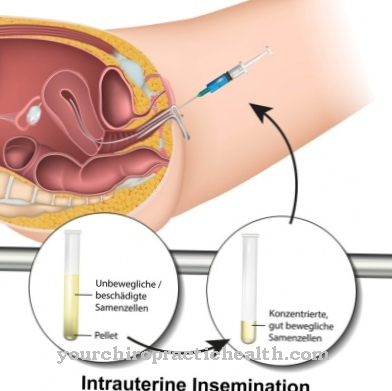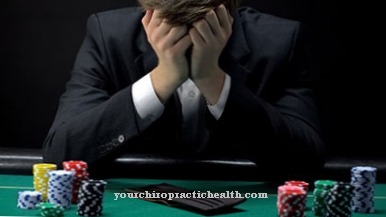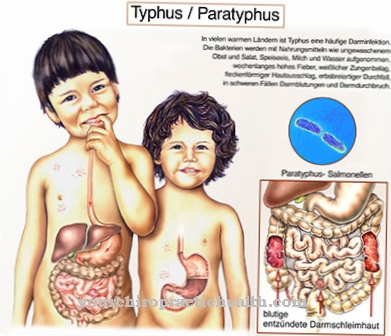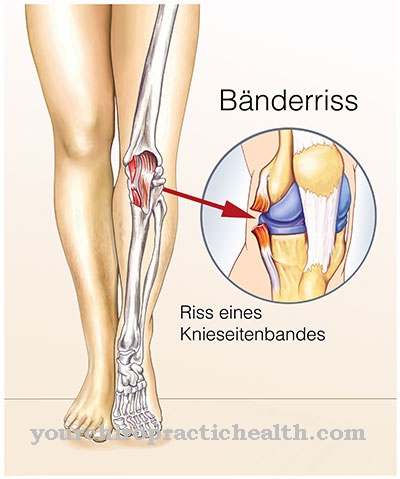In the multiple chemical intolerance, which are also called MCS is called, those affected react with sometimes severe symptoms to different and unrelated chemicals and substances. The course of the disease is chronic and can get worse over time. MCS restricts the quality of life and can lead to occupational disability.
What is multiple chemical intolerance?
The multiple chemical intolerance Characterizes a syndrome known since the eighties, which is characterized by multiple intolerances to many volatile chemical compounds. In the English-speaking area it is also called MCS (Multiple Chemical Sensitivity) designated.
MCS was the subject of heated controversy in the 1980s and 1990s as to the cause of the disease. It was discussed whether the multiple chemical intolerance is to be assigned to the field of toxicology or psychosomatics. It was observed that greater exposure to chemicals often led to the triggering of MCS.
MCS patients already suffer from the evaporation of the smallest amounts of volatile substances such as fragrances, exhaust gases, cigarette smoke or solvents, non-specific and diverse symptoms that greatly reduce their quality of life. However, the symptoms disappear immediately if the triggering substances are avoided.
causes
The reasons for the multiple chemical intolerance are not known. Today only explanatory attempts are made in order to be able to interpret the complex of symptoms. The majority of those affected were found to have been exposed to increased exposure to chemicals. These include formaldehyde, solvents and biocides. Usually the triggering chemicals are also neurotoxic. Nevertheless, the pollution is reversible in the majority of cases.
In a few cases, chemical sensitivity becomes chronic and even worsened to full-blown MCS. Over time, more and more chemicals are added that are not tolerated. Additional factors must be present for the development of an MCS. In addition to genetically caused defective detoxification reactions of the body, psychosomatic factors, existing allergies and other underlying diseases are also discussed.
Today it is assumed that the disease process is multifactorial, with toxicological and psychosomatic factors being equally involved. Respiratory diseases, allergies, food and drug intolerance, stress, anxiety disorders or post-traumatic stress disorders are considered to be risks.
The current state of research into the cause is in some cases still very unsatisfactory for those affected because they often feel that they are not being taken seriously. Due to the lack of clarity in the assignment to this syndrome, different prevalence rates for chemical intolerance were determined in different countries. While the prevalence in the USA is 3.9 percent, a value of 0.5 percent is given for Germany. This also makes it difficult to determine the cause of this disease. As a result, the prerequisites for a causal treatment of MCS are not yet in place.
Symptoms, ailments & signs
The multiple chemical intolerance manifests itself after exposure to very small amounts of volatile chemicals with many unspecific symptoms such as headache, fatigue, concentration disorders, dizziness, shortness of breath, gastrointestinal problems, rheumatic complaints or unclear pain. The disease is also characterized by the fact that the symptoms increase over time. At the same time, the number of substances that are not tolerated increases.
However, multiple chemical intolerance is clearly recognizable from specific features. Symptoms only occur when there is chemical exposure. There is no sign of improvement. The complaints always arise at low concentrations of the chemicals. When the triggering agent is removed, symptoms will go away immediately. The triggers are unrelated chemicals.
Several organs or organ systems are always involved in the disease process. The consequences for those affected are grave. They affect the quality of life, the professional life and the general performance of the sick. Even worse are the psychosocial consequences. Those affected feel stigmatized and marginalized because relatives, friends and doctors often do not take them seriously.
Diagnosis & course of disease
Due to the unclear reasons for the multiple chemical intolerance, a clear diagnosis is difficult. So far, there are no examination methods that can clearly diagnose the disease. The diagnosis of MCS is only made on the basis of the external appearance and the definition of the syndrome. Laboratory examinations and imaging tests remain inconclusive, however, because no organic changes can be found.
Complications
This chemical intolerance can lead to various complaints. As a rule, however, these only occur when the person concerned comes into contact with the respective chemicals. If contact is avoided, no further complications or complaints will arise.
The chemical intolerance leads to severe headaches or dizziness and severe fatigue. Disturbances in concentration or coordination can also occur. Furthermore, many sufferers also suffer from shortness of breath or from complaints in the stomach and intestines.
The patient's quality of life is considerably restricted by the chemical intolerance, provided that contact with the respective chemical is not interrupted. The symptoms will also increase over time if the disease is not treated. In the worst case, the person concerned can lose consciousness and possibly injure himself if he falls.
Since there is no direct treatment for chemical intolerance, there are no particular complications. By avoiding the respective substance, the symptoms can be significantly alleviated. If the illness occurs due to psychological causes, psychological treatment is necessary to limit the symptoms.
When should you go to the doctor?
If the person concerned experiences a diffuse sudden change in his health, he should check the environmental influences. If his breathing is exposed to the development of gas from chemicals, immediate action should be taken. In many cases it is sufficient to wear adequate respiratory protection and to spend a certain amount of time in an oxygen-rich environment. If the health complaints are significantly reduced after a few minutes, a doctor is often not required. If the symptoms are free after less than an hour, no further precautions need to be taken. If the existing symptoms increase or if an acute health-threatening condition develops, a doctor's visit is necessary. In particularly severe cases, an ambulance service must be alerted.
Tiredness, dizziness, coughing or concentration disorders should be examined and treated. If there are disorders of the gastrointestinal tract, irregularities in concentration, dizziness or headaches, action is required. In the event of rheumatic complaints, vomiting or nausea, a visit to a doctor is also advisable.
If the physical or mental performance decreases, psychological abnormalities or peculiarities of behavior become apparent, the person concerned needs help. Stomach pain, changes in food intake, loss of appetite, or irritability are other conditions that should be investigated and treated. If the quality of life falls, if there is a general malaise or if the person concerned suffers from a feeling of illness, a visit to a doctor is advisable.
Therapy & Treatment
There is currently no causal therapy for the multiple chemical intolerance. In addition to avoiding the triggering chemicals, psychotherapeutic measures are now offered. However, many of those affected find this situation unsatisfactory. It is true that there are ways of excluding chemical vapors as much as possible.
However, the price is often the complete isolation of the person concerned from their social environment. This aspect can even lead to an exacerbation of the disease. Even psychotherapeutic treatment often cannot bring the desired success because for many patients this is precisely the problem. They find it discriminatory that the illness should be traced back to psychological causes.
prevention
It is difficult to prevent multiple chemical intolerance. The disease is multifactorial and is often triggered by a single exposure to chemicals. However, such exposure can never be completely ruled out. Even so, a healthy lifestyle can help reduce the likelihood of multiple chemical intolerances.
A healthy diet, plenty of exercise and avoiding smoking and drinking lead to a strengthening of the immune system and, at the same time, to greater resistance to stress. Avoiding contact with pollutants and chemicals also reduces the risk of developing MCS.
Aftercare
Allergies require a change in everyday life from those affected. In particular, multiple intolerance can be overwhelming at the beginning. Follow-up care is advisable to support the patient in the new situation. How long the follow-up treatment lasts depends on the extent of the chemical intolerance.
The person concerned is looked after by an allergist. The goal is a largely unrestricted life despite incompatibility with the respective chemicals. At the beginning, the specialist determines which chemical substances are not tolerated by the patient. The person concerned receives an overview with the allergens. He discusses with the doctor how he should take the intolerance into account in his everyday life.
In the case of multiple chemical intolerance, the same procedure must be followed as in the case of allergies to food. Cleaning agents that contain allergens must no longer be used. Instead, the patient has to resort to harmless alternatives. Biodegradable household funds are offered in health food stores.
If he has worked in an environment where he has come into contact with the chemicals up to the time of diagnosis, he should change his area of activity in the company or consider retraining. In this case, in addition to medical care, career advice at the employment office is also part of the aftercare.
You can do that yourself
Multiple chemical intolerance can be counteracted by those affected themselves. The most important measure is to avoid the substances in question. People who react with allergic reactions to cigarette smoke or exhaust fumes must take precautionary measures to avoid contact with these substances in the first place. For this it may be necessary to change your job or your place of residence. Adjustments must also be made in the apartment. For example, air filters must be installed and tight windows built in to avoid environmental influences from outside.
In severe cases, special breathing masks must be worn. Since multiple chemical intolerance can go hand in hand with various complaints, the quality of life is often limited. The aim is to improve the quality of life through hobbies and an adapted lifestyle.
If you continue to feel unwell or have the typical feeling of constriction, visiting a self-help group can be useful. In conversation with others, those affected learn to deal better with the intolerance and receive valuable tips. In addition, an allergist or an internist must diagnose the disease and suggest suitable therapeutic measures. A drug treatment for the chemical intolerance is usually also possible.

.jpg)






















.jpg)



